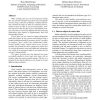Free Online Productivity Tools
i2Speak
i2Symbol
i2OCR
iTex2Img
iWeb2Print
iWeb2Shot
i2Type
iPdf2Split
iPdf2Merge
i2Bopomofo
i2Arabic
i2Style
i2Image
i2PDF
iLatex2Rtf
Sci2ools
SSDBM
1998
IEEE
1998
IEEE
Discrete Object Detection and Motion Registration Based on a Data Management Approach
When scientific data sets can be interpreted visually they are typically managed as pictures and consequently stored as large collections of bitmaps. Valuable information contained in images is often not exploited, however, simply because the data is not processed further. Common reasons for this are that access to information in image collections is notoriously difficult and that interesting applications often depend on supplementary data with incompatible formats. If such data sets are treated as higher-dimensional point data instead of byte streams and managed with a suitable multidimensional file structure, then it is possible to transform "fuzzy" objects into n-dimensional solids. Several benefits result: content based access becomes possible, the potential for data compression without loss of relevant information exists and additional information can readily be incorporated simply by increasing the file structure's dimensionality. This paper describes how this app...
| Added | 05 Aug 2010 |
| Updated | 05 Aug 2010 |
| Type | Conference |
| Year | 1998 |
| Where | SSDBM |
| Authors | Hans Hinterberger, Bettina Bauer-Messmer |
Comments (0)

